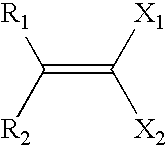Surgical adhesive compostion and process for enhanced tissue closure and healing
- Summary
- Abstract
- Description
- Claims
- Application Information
AI Technical Summary
Benefits of technology
Problems solved by technology
Method used
Image
Examples
Embodiment Construction
[0014] The present invention is directed to adhesive compositions and methods of using the compositions. The compositions of the present invention include a 1,1-disubstituted electron-deficient olefin macromer. Monomer and co-polymer design are used to improve the degradation behavior and biological performance of cyanoacrylates. The macromers of the invention can be stabilized and stored as mono-functional precursors with well-defined properties. Additional additives can be included.
[0015] Without wanting to be limited to any one theory, it is believed that the compositions of the present invention control in-vivo degradation behavior, wound healing, and tissue regeneration. It is further believed that brush-like pendant hydrophilic functionality masks the functionalized molecule or polymer from immunological recognition and toxic degradation. It is also believed that the inclusion of minimal oligo-peptide sequences can impart specific bioactivity and cell-mediated degradation to ...
PUM
| Property | Measurement | Unit |
|---|---|---|
| Phase transition temperature | aaaaa | aaaaa |
| Phase transition temperature | aaaaa | aaaaa |
| Temperature | aaaaa | aaaaa |
Abstract
Description
Claims
Application Information
 Login to View More
Login to View More - R&D
- Intellectual Property
- Life Sciences
- Materials
- Tech Scout
- Unparalleled Data Quality
- Higher Quality Content
- 60% Fewer Hallucinations
Browse by: Latest US Patents, China's latest patents, Technical Efficacy Thesaurus, Application Domain, Technology Topic, Popular Technical Reports.
© 2025 PatSnap. All rights reserved.Legal|Privacy policy|Modern Slavery Act Transparency Statement|Sitemap|About US| Contact US: help@patsnap.com



